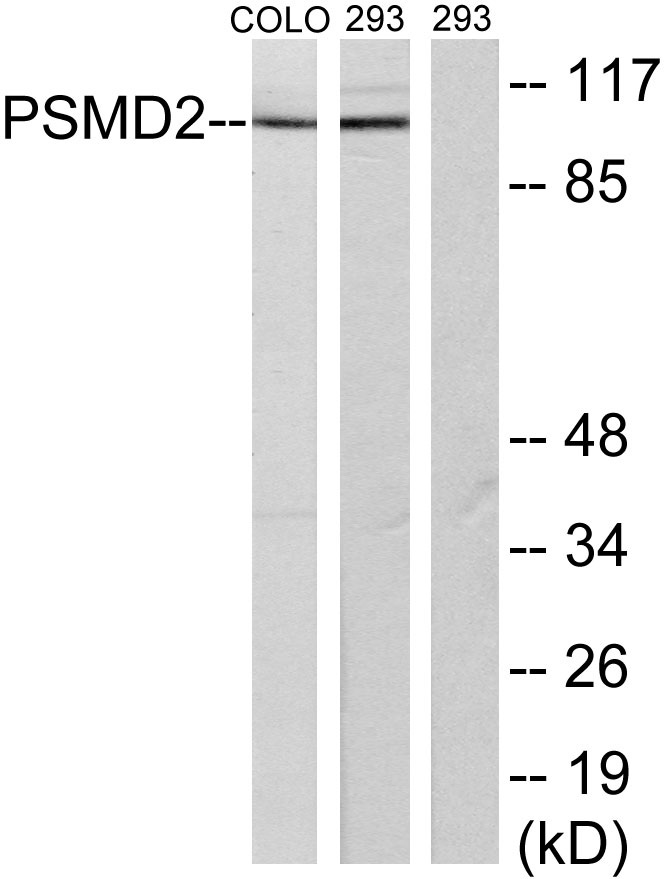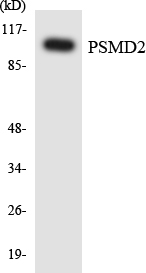PSMD2 Polyclonal Antibody
- Catalog No.:YT3888
- Applications:WB;IHC;IF;ELISA
- Reactivity:Human;Mouse;Rat
- Target:
- PSMD2
- Fields:
- >>Proteasome;>>Alzheimer disease;>>Parkinson disease;>>Amyotrophic lateral sclerosis;>>Huntington disease;>>Spinocerebellar ataxia;>>Prion disease;>>Pathways of neurodegeneration - multiple diseases;>>Epstein-Barr virus infection
- Gene Name:
- PSMD2
- Protein Name:
- 26S proteasome non-ATPase regulatory subunit 2
- Human Gene Id:
- 5708
- Human Swiss Prot No:
- Q13200
- Mouse Gene Id:
- 21762
- Mouse Swiss Prot No:
- Q8VDM4
- Rat Gene Id:
- 287984
- Rat Swiss Prot No:
- Q4FZT9
- Immunogen:
- The antiserum was produced against synthesized peptide derived from human PSMD2. AA range:101-150
- Specificity:
- PSMD2 Polyclonal Antibody detects endogenous levels of PSMD2 protein.
- Formulation:
- Liquid in PBS containing 50% glycerol, 0.5% BSA and 0.02% sodium azide.
- Source:
- Polyclonal, Rabbit,IgG
- Dilution:
- WB 1:500 - 1:2000. IHC 1:100 - 1:300. IF 1:200 - 1:1000. ELISA: 1:20000. Not yet tested in other applications.
- Purification:
- The antibody was affinity-purified from rabbit antiserum by affinity-chromatography using epitope-specific immunogen.
- Concentration:
- 1 mg/ml
- Storage Stability:
- -15°C to -25°C/1 year(Do not lower than -25°C)
- Other Name:
- PSMD2;TRAP2;26S proteasome non-ATPase regulatory subunit 2;26S proteasome regulatory subunit RPN1;26S proteasome regulatory subunit S2;26S proteasome subunit p97;Protein 55.11;Tumor necrosis factor type 1 receptor-associated protein
- Observed Band(KD):
- 100kD
- Background:
- The 26S proteasome is a multicatalytic proteinase complex with a highly ordered structure composed of 2 complexes, a 20S core and a 19S regulator. The 20S core is composed of 4 rings of 28 non-identical subunits; 2 rings are composed of 7 alpha subunits and 2 rings are composed of 7 beta subunits. The 19S regulator is composed of a base, which contains 6 ATPase subunits and 2 non-ATPase subunits, and a lid, which contains up to 10 non-ATPase subunits. Proteasomes are distributed throughout eukaryotic cells at a high concentration and cleave peptides in an ATP/ubiquitin-dependent process in a non-lysosomal pathway. An essential function of a modified proteasome, the immunoproteasome, is the processing of class I MHC peptides. This gene encodes one of the non-ATPase subunits of the 19S regulator lid. In addition to participation in proteasome function, this subunit may also participate
- Function:
- function:Acts as a regulatory subunit of the 26 proteasome which is involved in the ATP-dependent degradation of ubiquitinated proteins.,function:Binds to the intracellular domain of tumor necrosis factor type 1 receptor. The binding domain of TRAP1 and TRAP2 resides outside the death domain of TNFR1.,similarity:Belongs to the proteasome subunit S2 family.,similarity:Contains 7 PC repeats.,tissue specificity:Found in skeletal muscle, liver, heart, brain, kidney, pancreas, lung and placenta.,
- Subcellular Location:
- proteasome complex,nucleus,nucleoplasm,cytosol,proteasome regulatory particle,proteasome regulatory particle, base subcomplex,membrane,proteasome accessory complex,proteasome storage granule,extracellular exosome,
- Expression:
- Found in skeletal muscle, liver, heart, brain, kidney, pancreas, lung and placenta.
- June 19-2018
- WESTERN IMMUNOBLOTTING PROTOCOL
- June 19-2018
- IMMUNOHISTOCHEMISTRY-PARAFFIN PROTOCOL
- June 19-2018
- IMMUNOFLUORESCENCE PROTOCOL
- September 08-2020
- FLOW-CYTOMEYRT-PROTOCOL
- May 20-2022
- Cell-Based ELISA│解您多样本WB检测之困扰
- July 13-2018
- CELL-BASED-ELISA-PROTOCOL-FOR-ACETYL-PROTEIN
- July 13-2018
- CELL-BASED-ELISA-PROTOCOL-FOR-PHOSPHO-PROTEIN
- July 13-2018
- Antibody-FAQs
- Products Images

- Western Blot analysis of various cells using PSMD2 Polyclonal Antibody
.jpg)
- Western Blot analysis of 293 cells using PSMD2 Polyclonal Antibody

- Immunohistochemical analysis of paraffin-embedded Human cervix cancer. Antibody was diluted at 1:100(4° overnight). High-pressure and temperature Tris-EDTA,pH8.0 was used for antigen retrieval. Negetive contrl (right) obtaned from antibody was pre-absorbed by immunogen peptide.

- Western blot analysis of lysates from COLO205 and 293 cells, using PSMD2 Antibody. The lane on the right is blocked with the synthesized peptide.

- Western blot analysis of the lysates from HepG2 cells using PSMD2 antibody.



